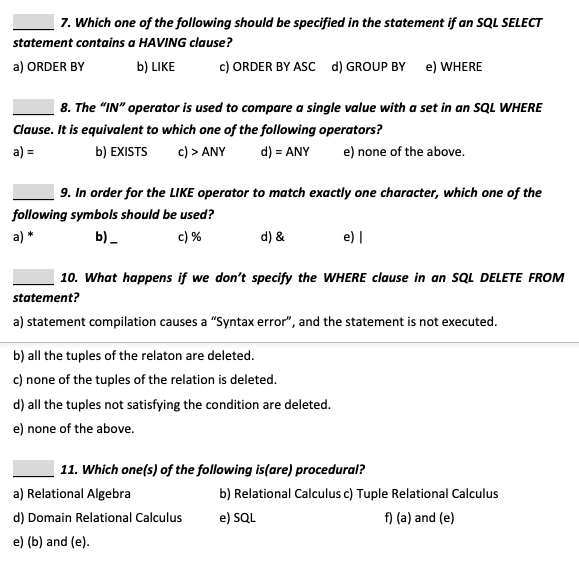| 7. Which one of the following should be specified in the statement if an SQL SELECT statement contains a HAVING clause? a) ORDER BY b) LIKE c) ORDER BY ASC d) GROUP BY e) WHERE
| 7. Which one of the following should be specified in the statement if an SQL SELECT statement contains a HAVING clause? a) ORDER BY b) LIKE c) ORDER BY ASC d) GROUP BY e) WHERE
Programming with Microsoft Visual Basic 2017
8th Edition
ISBN:9781337102124
Author:Diane Zak
Publisher:Diane Zak
Chapter12: Database Queries With Sql
Section: Chapter Questions
Problem 1E
Related questions
Question
answer the question please

Transcribed Image Text:7. Which one of the following should be specified in the statement if an SQL SELECT
statement contains a HAVING clause?
a) ORDER BY
b) LIKE
c) ORDER BY ASC d) GROUP BY e) WHERE
| 8. The "IN" operator is used to compare a single value with a set in an SQL WHERE
Clause. It is equivalent to which one of the following operators?
a) =
b) EXISTS
c) > ANY
d) = ANY
e) none of the above.
| 9. In order for the LIKE operator to match exactly one character, which one of the
following symbols should be used?
a) *
b) -
c) %
d) &
e) |
10. What happens if we don't specify the WHERE clause in an SQL DELETE FROM
statement?
a) statement compilation causes a "Syntax error", and the statement is not executed.
b) all the tuples of the relaton are deleted.
c) none of the tuples of the relation is deleted.
d) all the tuples not satisfying the condition are deleted.
e) none of the above.
11. Which one(s) of the following is(are) procedural?
a) Relational Algebra
b) Relational Calculus c) Tuple Relational Calculus
d) Domain Relational Calculus
e) SQL
f) (a) and (e)
e) (b) and (e).
Expert Solution
This question has been solved!
Explore an expertly crafted, step-by-step solution for a thorough understanding of key concepts.
Step by step
Solved in 2 steps

Knowledge Booster
Learn more about
Need a deep-dive on the concept behind this application? Look no further. Learn more about this topic, computer-science and related others by exploring similar questions and additional content below.Recommended textbooks for you

Programming with Microsoft Visual Basic 2017
Computer Science
ISBN:
9781337102124
Author:
Diane Zak
Publisher:
Cengage Learning

Np Ms Office 365/Excel 2016 I Ntermed
Computer Science
ISBN:
9781337508841
Author:
Carey
Publisher:
Cengage

COMPREHENSIVE MICROSOFT OFFICE 365 EXCE
Computer Science
ISBN:
9780357392676
Author:
FREUND, Steven
Publisher:
CENGAGE L

Programming with Microsoft Visual Basic 2017
Computer Science
ISBN:
9781337102124
Author:
Diane Zak
Publisher:
Cengage Learning

Np Ms Office 365/Excel 2016 I Ntermed
Computer Science
ISBN:
9781337508841
Author:
Carey
Publisher:
Cengage

COMPREHENSIVE MICROSOFT OFFICE 365 EXCE
Computer Science
ISBN:
9780357392676
Author:
FREUND, Steven
Publisher:
CENGAGE L
